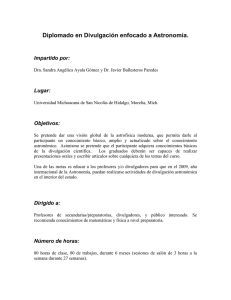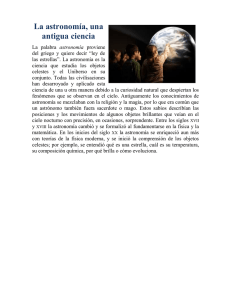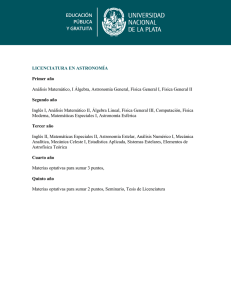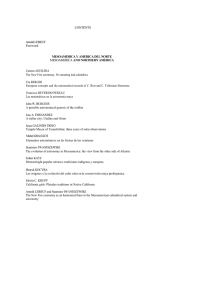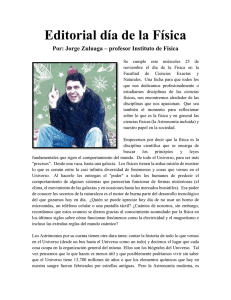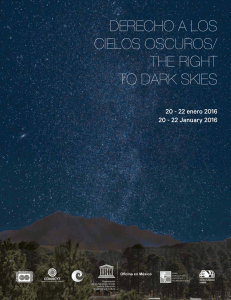Chile The astronomical capital of the world
Anuncio
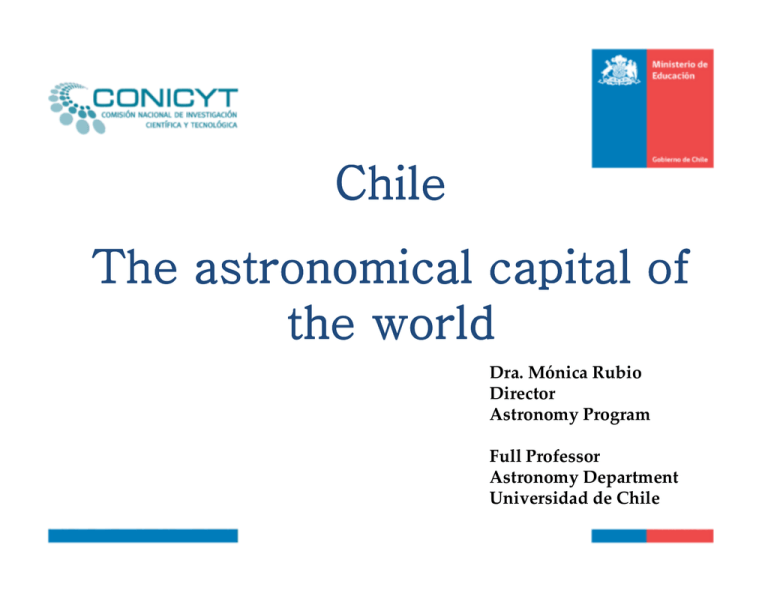
Chile The astronomical capital of the world Dra. Mónica Rubio Director Astronomy Program Full Professor Astronomy Department Universidad de Chile 4M Palomar Lick 19851990 Kitt Peak (WIYN) (APO) CFHT WHT CTIO AAT ESO3.6 La Palma 8M Keck I & II Gemini N 20051990 Subaru MMT (LBT) (GTC) VLT – 4 Magellan – 2 Gemini S La Palma Primeros Observatorios EEntre 1995 y 2000 se instalan los primeros grandes telescopios ópticos e Infrarrojos en Chile CCerro Pachón: 4m SOAR, 8m Gemini CCerro Las Campanas: 6.5m Magellanes CCerro Paranal: 8m VLT Lo que viene (1) • MMás de USD 4.1b en inversiones comprometidas LLlano Chajnantor: 66x 12m ALMA CCerro Chajnantor: 6.5m TAO CCerro Pachón: 8m LSST Instrumentación Desafíos Correlator: 34*10 millones de operaciones por segundo 9 ASTRONOMICAL DATA Production and Storage Telescope Size Observatory VISTA 4.0m Paranal 1.4 ALMA 66x12m Chajnantor 0.5 DES/DECam 4.0m CTIO LSST 8m Pachon TELESCOPE DATA STORAGE VLT 20 Tb/yr LSST 1000 Tb/yr Tb/day 100 bps continous 100% 24/7 reliability 0.4 30 1 GigaB = 109 1 TeraB = 1012 b 1 PetaB = 1015 b 1 Petabyte * * 2 x LHC (Large Hadron Collider) Barba et al. 2008 Kawax study Imagen VVV survey Miniti et al. Vista telescope Lo que viene (2) EEl E-ELT será el telescopio Óptico-IR más grande del mundo LCerro Chajnantor: 25m CCAT CCerro Las Campanas: 25m GMT CCerro Armazones: 42m E-ELT Investments Operating Magellan Telescopes Gemini VLT ACT In constructi0n ALMA Proyected TAO LSST CCAT GMT E-ELT Diameter Cost USD Tipe 2x 6.5m 8.2m 4x 8.2m 6.0m 100m 300m 700m 40m Óptico/IR Óptico/IR Óptico/IR Radio/Sub-mm 66x 12.0m 1,000m Radio/Sub-mm 6.5m 8.2m 25.0m 25.0m 42.0m 100m 500m 200m 800m 1,500m Óptico/IR Óptico/IR Radio/Sub-mm Óptico/IR Óptico/IR Total= 5.800m ELTs TMT GMT EELT Others ALMA LSST SKA/MWA 20201990 La Palma CHALLENGES Develop tools to be able to do the research from these plentiful and complex data Requires -Technological Technological processing -Storage Storage -Network Network capacity -Connectivity Connectivity ASTRONOMY Astronomy = Pure Science Large Telescope Technology Driven Radio Interferometer Drives Technology Satellites Powerful computers Networks A good case to show the relationship between Science - TechnologyTechnology- Industry Astronomy is an industrial Science Future of Science and Technology New fields Engineers Mathematicians Physicist Software Specialists ReadyReady-data services : exported to AstroAstro- informatics AstroAstro-data management Virtual Observatories Data bases Data mining retail, banking, finance, governme meteorology, simulations BIG SCIENCE • ASTRONOMY •PARTICLE PARTICLE PHYSICS Vigroux.L. 2010 In Europe, ESO and ESA are the main providers of large industry contracts Vigroux.L. 2010 “Astronomy projects are challenging projects able to motivate industrial teams”. Mr. Seznec, CEO of Thales Alenia Space, introductory talk during the opening ceremony for the International Year of Astronomy CONICYT FUNDING OF ASTRONOMY CONICYT P. ASTRONOMIA US$/yr 1.000.000 FONDECYT 800.000 ANILLOS 150.000 FONDAP 600.000 BASAL 1.000.000 Total 3.550.000 Desafío •Instalacion de una infraestructura de punta a nivel global. •Desarollo de una cienca en la cual Chile puede ser un jugador de excelencia en el mundo. •Creación de una capacidad tecnológica Proyectar el desarrrollo de servicios y tecnologia de apoyo de primer nivel . (taratmineto de datos, mantenimiento de equipos , tecnologia para el soporte , y Desarrollo de instrumentación astronómica Participación en la ingeniería de punta de los proyectos astronómicos internacionales que se instalarán en Chile • Creación de un Parque Astronomico Atacama. •Protección Protección efectiva de los sitios de observación (contaminación lumínica) Impact of fundamental research on a society including its economical importance is recognized by many governments which use fundamental research as a development tool to improve their economy. Desafío/Oportunidad Chile : un actor a nivel mundial en Astronomía La rama de la ciencia Chile:en que podemos ser toptop-10 Polo de desarrollo global de la astronomía La Capital Mundial de la Astronomía MANY THANKS The overall impact of astronomy and space science in Europe, beyond direct salaries of academicinstitutions and the contribution to European Organization (ESO and ESA) has 2 main components: - The expenditure through contract to industry if of the order of 500 M€ M€/y - in addition 1000 M€ M€/y generated in European economy. In total, the return to European economy is 3 times more than the direct contribution of member states to ESO and ESA. L.Vigroux, 2010 Examples Radioastronomy Adaptive Optics Detectors Software Algorithms RADIOASTRONOMY Forefront of performance in - High gain antenna in cm , mm and submm domain - Low noise and high gain amplifier - Digital programming - Massive data analysis Invented the Apersrture Synthesis Imaging techniques Wide field maps at radiofreceuncies Use in Xay medical imaging Medical Tomograpphy Brain imaging Discovery of Radio emission form the Galaxy 1936 -Sincroton Sincroton emission - studies of material specially in molecular biology Development of new switching frequencies techniques to improve detector sensititvity @1400 MHz Led to the discovery of 21 cm Hydrogen emission ADAPTIVE OPTICS Fundamental technique for Extremly Large teelscopes ( > 30 m) E-ELT, TMT, GMT -Ophtalmology Ophtalmology -Spin SpinSpin-off companies with hopsitals to design adaptive optics for - image retina or focurs laser on retinas DETECTORS -CCDs CCDs (Photoelectric effect electric current -Improvement Improvement on manufacturing process in common by -astronomy astronomy and industry to optimize CCD Decreasing pixel size LSST camera Bolometers (light heat (thermometer ) readout electronics probing tempe Silicon etching & microelectronis bidemensional arrays bolometers Microbolometer cameras TV Astrónomos en Universidades Chilenas Fondo Alma, Gemini 80 70 60 50 40 30 20 10 0 1994 1997 Total UCH 2000 PUC UdeC 2003 UV ULS UCN 2006 UTA UMCE UNAB Estudiantes : Master + PhD 80 70 60 Number 50 40 30 20 10 0 1993 1997 2001 Year 2005 2010 Personal académico en Astronomía Profesores 2010 = 62 5 11 4 4 UCH PUC UdeC UdeV ULS UCN UTA UMCE 16 10 14 7 UNAB Profesores + Postdoctorados 2010 30 25 20 Profesores 2010 = 62 15 Postdoctorados 2010 = 48 Profesores + Postdocs 2010 = 110 10 5 0 UCH PUC UdeC UdeV ULS UCN UTA UMCE UNAB • Parque Astronómico Conicyt Polo geográfico, tecnológico y de atracción turística – Interés de japoneses por usar el parque ALMA Commisioning 6 antennas CERRO TOCO CERRO CHAJNANTOR CERRO CHAJNANTOR RESULTADO • Atacama es un excelente y único lugar para las observaciones submilimétricas gracias al buen clima y la gran transparencia atmosférica • Con los proyectos que se están construyendo, en menos de una década y para el bicentenario 2018, Chile tendrá el 68% de la proporción de los telescopios instalados en el mundo* – Cambio en el market share astronómico • Oportunidad única de desarrollo donde existan competencias y caminos recorridos Desafío • Contribuir a aumentar el numero de astrónomos en instituciones Chilenas • Fondos de contraparte para iniciativas conjuntas internacionales. • Fortalecer los programas de Doctorado en Astronomía en Universidades Chilenas • La astronomía como “vehiculo ” para atraer a los estudiantes en los colegios a acercarse a la ciencia. Millimeter Radioastronomy Laboratory Band 1 ALMA receiver prototype http://www.das.uchile.cl/lab_mwl Interest to collaborate with CCAT ZEUS visitor instrument in APEX ( E. Michael , Electrical Eng. Dept- UCH). Centro de Astro - Ingenieria of PUC http://aiuc.puc.cl/ READOUT ELECTRONICS Prof. M. Guarini INFRARED DETECTORS Prof. L Vanzi ADAPTIVE OPTICS Prof. A. Guesalaga, A. Guzman SIMPLE Prof. L Vanzi Radio-Astronomy at U.de Concepción (UdeC) - Long-term experience in the Chajnantor area. - Collaboration with CBI/QUIET since 2002: - 3 Ph.Ds, 2 engineers, several observers (students). - Operations, engineering, observations, CMB science. - TIGO VLBI 6m telescope on UdeC campus: - Training of EE and Astronomy students. - Radio-Astronomy Laboratory, UdeC: - 183 GHz water vapor radiometers at the QUIET and CCAT site - Development of low cost digital 183 GHz radiometer next to QUIET oxygen and water vapor radiometers. Capital Humano Avanzado • Colaboración con universidades e instituciones internacionales de primer nivel • Entrenar gente y re-insertarla en la industria: – Ingenieros mecánicos, eléctricos, ópticos, de software y técnicos respectivos – Astrónomos • Mantención & Operación – Sistemas TI (i.e. administración de sistemas & de bases de datos) Programa de Astronomía Creado en el 2006 Misión La misión del programa es - apoyar y fomentar el desarrollo de la astronomía nacional, - relevar esta disciplina como un área estratégica de desarrollo de la ciencia en nuestro país -Coordinar Coordinar las acciones nacionales en Astronomía -- lograr ser una potencia mundial en esta disciplina Programa de Astronomía Proporción de los telescopios instalados en de Chile Resto del Mundo Proporción: CHILE Existente 66.29 33.71 Futura 22.37 77.63 Total 32.25 67.75 * área de los espejos
